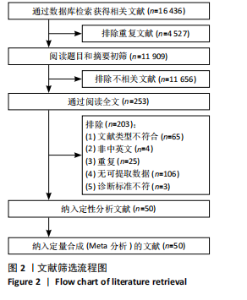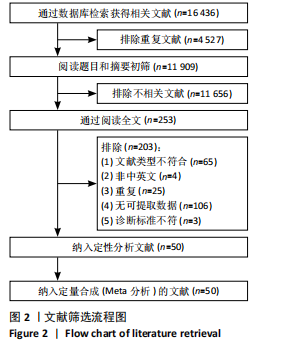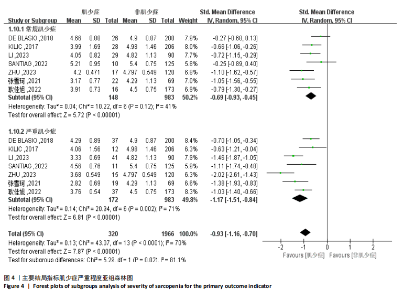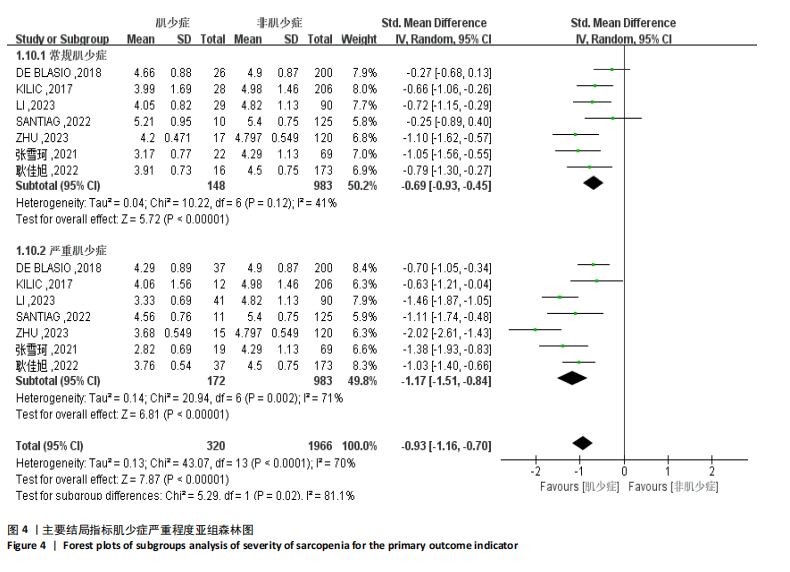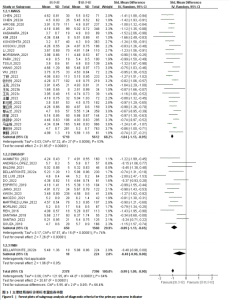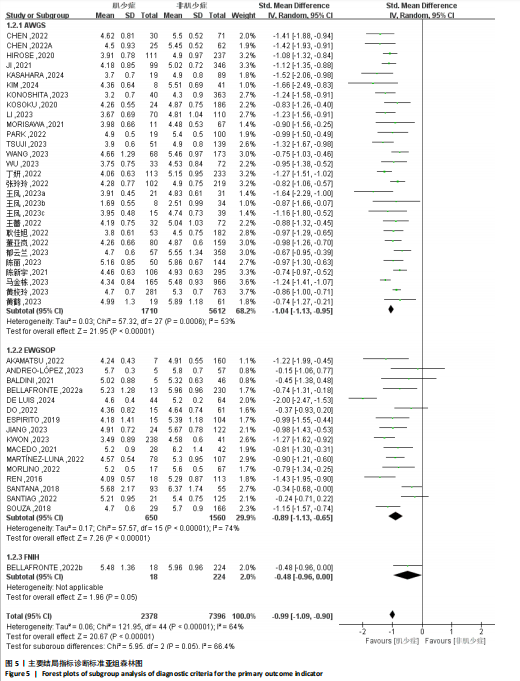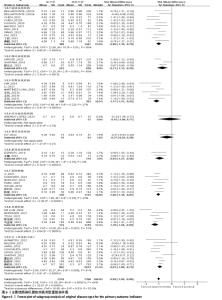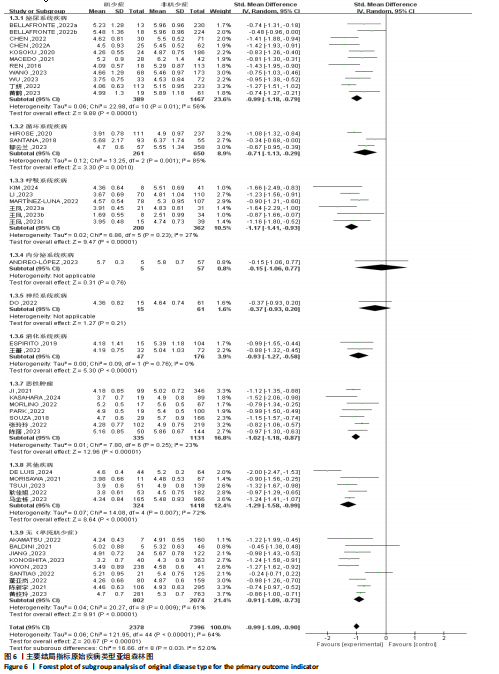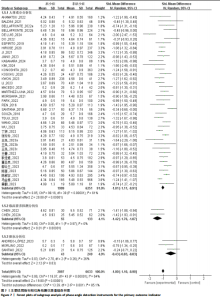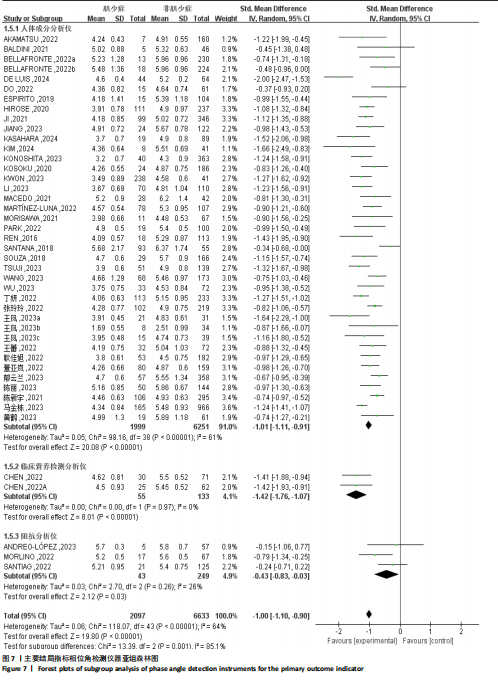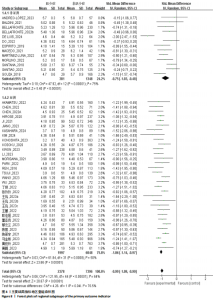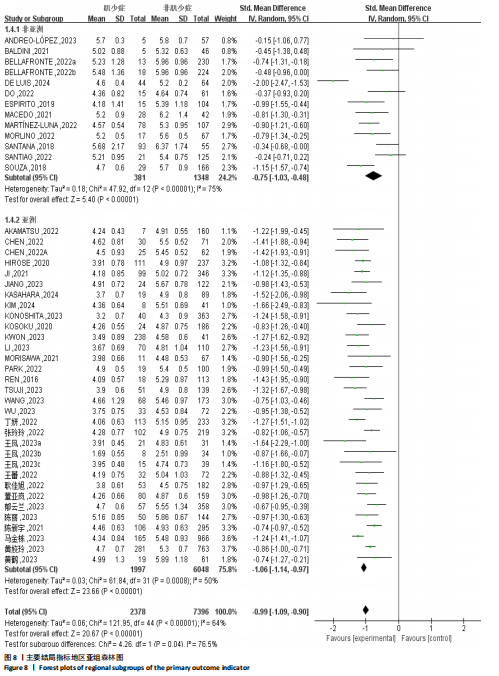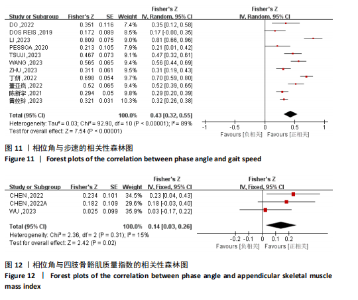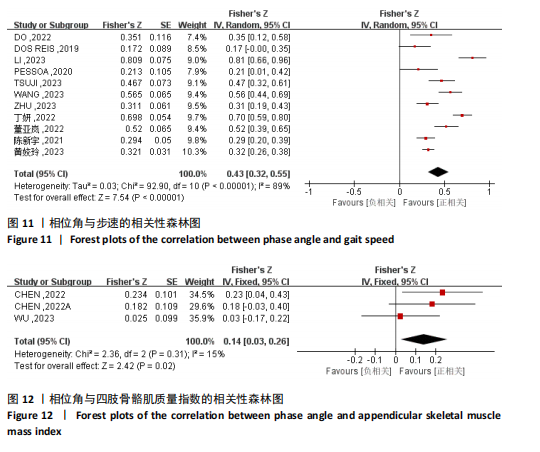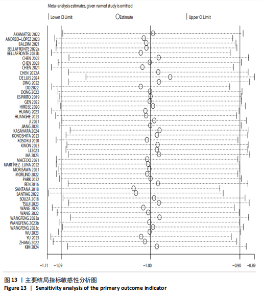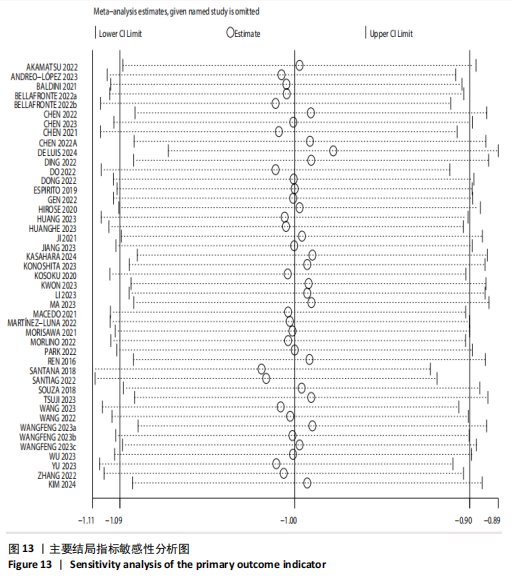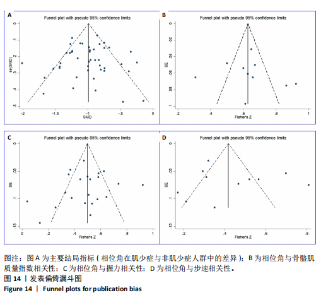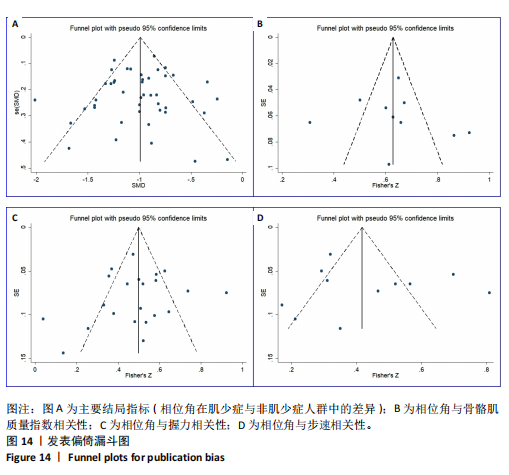Chinese Journal of Tissue Engineering Research ›› 2025, Vol. 29 ›› Issue (12): 2575-2589.doi: 10.12307/2025.358
Previous Articles Next Articles
Meta-analysis of the correlation between phase angle and sarcopenia and its diagnostic indexes
Chen Jiayi1, Li Huijing2, Nong Yuxuan1, Yin Yunfang1, Liu Xiaobo1, Chen Yue3, Hu Xiaoshen1, Zhong Dongling1, Li Juan1, Liu Tianyu4, #br# Jin Rongjiang1#br#
- 1School of Health Cultivation and Rehabilitation, 2School of Clinical Medicine, 4School of Physical Education and Health, Chengdu University of Traditional Chinese Medicine, Chengdu 610075, Sichuan Province, China; 3Chengdu Gu Lian Jin Chen Rehabilitation Hospital, Chengdu 610000, Sichuan Province, China
-
Received:2024-04-01Accepted:2024-05-22Online:2025-04-28Published:2024-09-11 -
Contact:Jin Rongjiang, MD, Professor, School of Health Cultivation and Rehabilitation, Chengdu University of Traditional Chinese Medicine, Chengdu 610075, Sichuan Province, China Co-corresponding author: Liu Tianyu, MD, Associate professor, School of Physical Education and Health, Chengdu University of Traditional Chinese Medicine, Chengdu 610075, Sichuan Province, China -
About author:Chen Jiayi, Master candidate, School of Health Cultivation and Rehabilitation, Chengdu University of Traditional Chinese Medicine, Chengdu 610075, Sichuan Province, China -
Supported by:the Youth Fund for Humanities and Social Sciences Research of the Ministry of Education of China, No. 19YJC890027 (to LTY); Major Science and Technology Application Demonstration Project in Chengdu, No. 2022-YF09-00058-SN (to LTY)
CLC Number:
Cite this article
Chen Jiayi, Li Huijing, Nong Yuxuan, Yin Yunfang, Liu Xiaobo, Chen Yue, Hu Xiaoshen, Zhong Dongling, Li Juan, Liu Tianyu, Jin Rongjiang. Meta-analysis of the correlation between phase angle and sarcopenia and its diagnostic indexes[J]. Chinese Journal of Tissue Engineering Research, 2025, 29(12): 2575-2589.
share this article
Add to citation manager EndNote|Reference Manager|ProCite|BibTeX|RefWorks
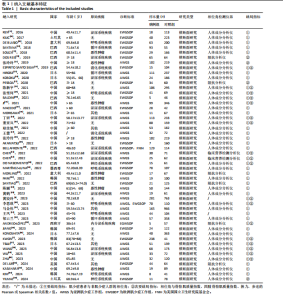
2.2 纳入文献基本特征与偏倚风险评价结果 纳入文献基本特征如表1所示,共纳入50篇文献,均为横断面研究。仅2篇文献未具体描述相位角检测仪器[6,52],其余均描述了相位角的测量仪器,包括人体成分分析仪、阻抗分析仪和临床营养检测分析仪,均测量50 kHz频率下相位角。偏倚风险评价结果如表2所示,大多数研究为中等质量,仅2篇研究为高质量[31,35]。 2.3 Meta分析结果 2.3.1 相位角在肌少症与非肌少症人群中的差异 42篇文献45项研究描述了相位角在肌少症与非肌少症人群中的差异[6-7,17,20-21,24-26,28,30-59,61-63],共包括9 774例样本量。异质性检验(I2=64%,P < 0.000 01)具有较大的异质性,分析原因可能与纳入患者基本特征存在差异、相位角测量仪器及操作流程不同等因素相关,故采用随机效应模型进行分析。结果显示,肌少症患者的相位角显著低于非肌少症人群[SMD=-0.99,95%CI(-1.09,-0.90),P < 0.000 01],见图3。 2.3.2 亚组分析 按肌少症严重程度、诊断标准、原始疾病类型、相位角检测仪器种类以及地区分别进行亚组分析,结果见表3,图4-8。 常规肌少症患者(SMD=-0.69)和重度肌少症患者(SMD=-1.17)相位角均明显低于非肌少症人群,且重度肌少症患者比常规肌少症患"
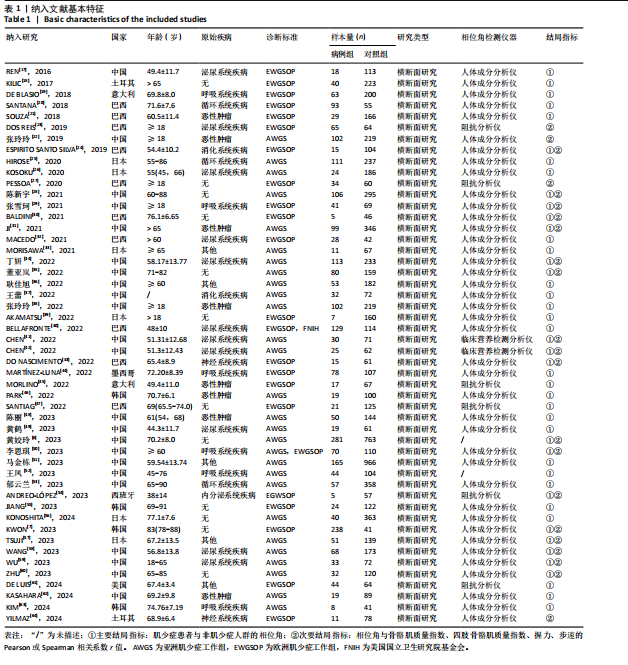
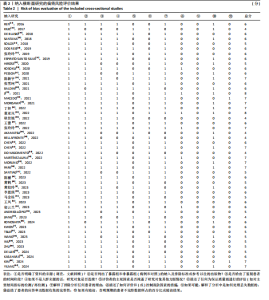
者的相位角更低(P < 0.05)。根据AWGS(SMD=-1.04)、EWGSOP(SMD=-0.89)诊断标准确诊的肌少症患者相位角均低于非肌少症人群,但组间差异无统计学意义。 患有泌尿系统疾病(SMD=-0.99)、循环系统疾病(SMD=-0.71)、呼吸系统疾病(SMD=-1.17)、消化系统疾病(SMD=-0.93)、恶性肿瘤(SMD=-1.02)及其他疾病(SMD=-1.29)伴有肌少症或单纯肌少症(SMD=-0.91)患者相位角均低于非肌少症人群,且组间差异存在统计学意义(P < 0.05)。 肌少症患者依据人体成分分析仪和临床营养检测分析仪测量的相位角均低于非肌少症人群,且临床营养检测分析仪测量的相位角降低更加明显(P < 0.05)。 非亚洲(SMD=-0.75)和亚洲(SMD=-1.06)地区肌少症患者的相位角均低于非肌少症人群,且亚洲地区肌少症患者降低更加显著(P < 0.05)。 2.3.3 相位角与骨骼肌质量指数的相关性 10项研究描述了相位角与骨骼肌质"
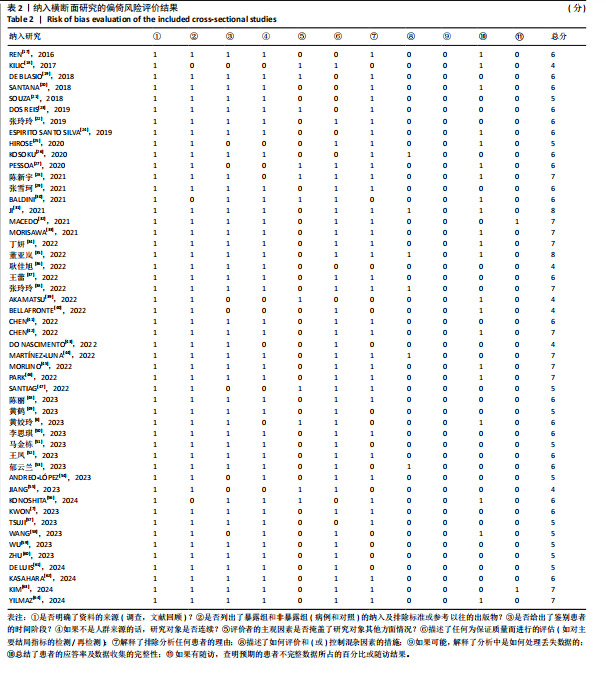
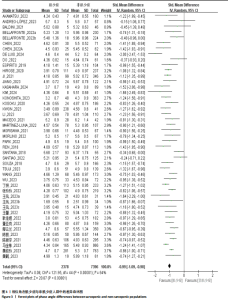
量指数的相关性[6,28-29,31,34-35,50,57-58,60],共包括3 466例样本量。异质性检验(I2=85%,P < 0.000 01)显示具有较大的异质性,故采用随机效应模型进行分析。结果显示,相位角与骨骼肌质量指数呈正相关[Fisher’s Z=0.64,95%CI(0.55,0.73),P < 0.000 01],见图9,经换算得到Summary r值为0.565,二者呈中等相关性。在剔除TSUJI等[57]和WANG等[58]研究后,异质性明显降低(I2=62%,P=0.01),分析原因可能与纳入人群来源以及骨骼肌质量指数测量方式不同有关,但逐个剔除文献后,结果无实质性改变,说明此结果较稳定。 2.3.4 相位角与握力的相关性 21项研究描述了相位角与握力的相关性,共包括4 980例样本量[6-7,22-24,27-31,34-35,41-43,50,54,57-58,60,64]。 异质性检验(I2=81%,P < 0.000 01)显示具有较大的异质性,故采用随机效应模型进行分析。结果显示,相位角与握力呈正相关[Fisher’s Z=0.48,95%CI(0.41,0.56),P < 0.000 01],见"
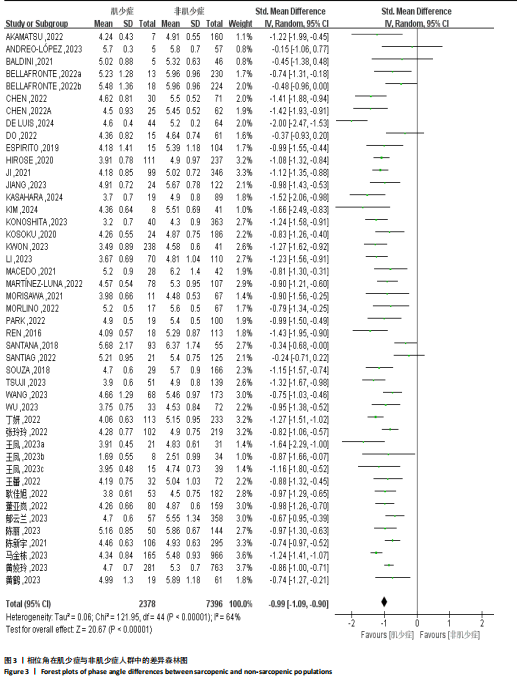
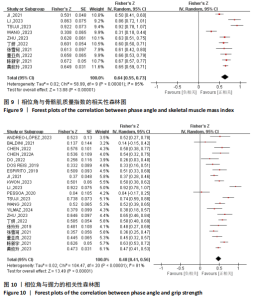
图10,经换算得到Summary r值为0.446,呈中等相关。在剔除李思琪[50]和PESSOA等[27]研究后异质性明显降低(I2=66%,P < 0.000 1),分析原因可能为李思琪[50]研究纳入患者年龄较大且疾病严重程度较高,而PESSOA等[27]纳入的为定期参加体育锻炼的老年人群有关。在逐个剔除文献后,结果无实质性改变,说明此结果较稳定。 2.3.5 相位角与步速的相关性 11项研究描述了相位角与步速的相关 性[6,23,27-28,34-35,43,50,57-58,60],共包括3 211例样本量。异质性检验(I2=89%,P < 0.000 01)显示具有较大的异质性,故采用随机效应模型进行分析。结果显示,相位角与步速呈正相关[Fisher’s Z=0.43,95%CI(0.32,0.55),P < 0.000 01],见图11,经换算得到Summary r值为0.405,呈中等相关。在剔除WANG等[58]、丁妍等[34]和李思琪[50]研究后,异质性明显降低(I2=59%,P=0.02),分析原因可能为纳入患者步行功能严重受限,影响步速的测量结果。但逐个剔除文献后,结果无实质性改变,说明此结果较稳定。 2.3.6 相位角与四肢骨骼肌质量指数的相关性 3项研究描述了相位角与步速的相关性[41-42,59],共包括293例样本量。异质性检验(I2=15%,P < 0.000 01)显示具有较小的异质性,故采用固定效应模型进行分析。结果表明,相位角与四肢骨骼肌质量指数呈正相关[Fisher’s Z=0.14,95%CI(0.03,0.26),P=0.02],见图12,经换算得到Summary r值为0.139,呈极弱相关。 2.4 敏感性分析 采取逐一剔除文献法对主要结局指标进行敏感性分析,结果未因研究数量的变化而发生显著改变,提示研究结果较稳定,见图13。 2.5 发表偏倚检验 采用漏斗图和Egger’s检验对纳入研究数量≥10篇的结局指标进行发表偏倚检测。结果显示,在主要结局指标中各研究分布大致对称,P=0.826 > 0.05,提示无显著发表偏倚,见图14。在相位角与骨骼肌质量指数(P=0.752)、握力(P=0.684)和步速(P=0.566)相关性的结局指标中也均提示无显著发表偏倚。"
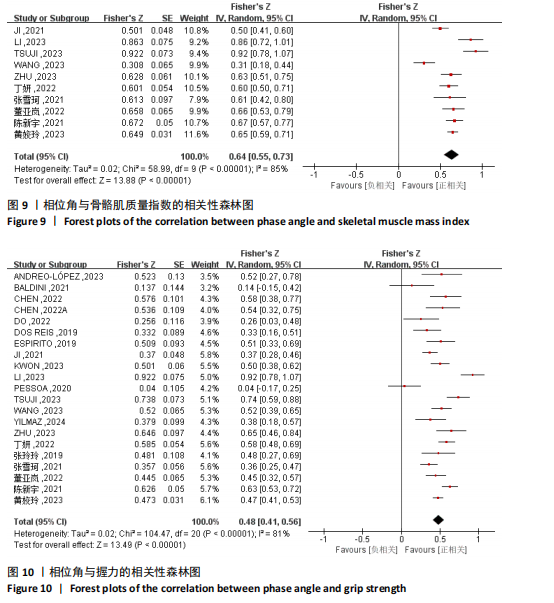
| [1] CRUZ-JENTOFT AJ, SAYER AA. Sarcopenia. Lancet. 2019;393(10191):2636-2646. [2] YUAN S, LARSSON SC. Epidemiology of sarcopenia: Prevalence, risk factors, and consequences. Metabolism. 2023;144:155533. [3] BASILE C, DELLA-MORTE D, CACCIATORE F, et al. Phase angle as bioelectrical marker to identify elderly patients at risk of sarcopenia. Exp Gerontol. 2014;58:43-46. [4] GARLINI LM, ALVES FD, CERETTA LB, et al. Phase angle and mortality: a systematic review. Eur J Clin Nutr. 2019;73(4):495-508. [5] ROSAS-CARRASCO O, RUIZ-VALENZUELA RE, LÓPEZ-TEROS MT. Phase Angle Cut-Off Points and Their Association With Sarcopenia and Frailty in Adults of 50-64 Years Old and Older Adults in Mexico City. Front Med (Lausanne). 2021;8:617126. [6] 黄姣玲,华楠,李玉华,等.相位角在社区老年人肌少症筛查中的应用[J].护理研究,2023, 37(10):1724-1728. [7] KWON YE, LEE JS, KIM JY, et al. Impact of sarcopenia and phase angle on mortality of the very elderly. J Cachexia Sarcopenia Muscle. 2023;14(1):279-287. [8] CRUZ-JENTOFT AJ, BAHAT G, BAUER J, et al. Sarcopenia: revised European consensus on definition and diagnosis. Age Ageing. 2019;48(1): 16-31. [9] 杨光.248例原发性肝癌患者生物电阻抗相位角数值与预后的相关性分析[D].长春:吉林大学,2020. [10] CHEN LK, LIU LK, WOO J, et al. Sarcopenia in Asia: consensus report of the Asian Working Group for Sarcopenia. J Am Med Dir Assoc. 2014;15(2):95-101. [11] CHEN LK, WOO J, ASSANTACHAI P, et al. Asian Working Group for Sarcopenia: 2019 Consensus Update on Sarcopenia Diagnosis and Treatment. J Am Med Dir Assoc. 2020;21(3):300-307.e2. [12] CRUZ-JENTOFT AJ, BAEYENS JP, BAUER JM, et al. Sarcopenia: European consensus on definition and diagnosis: Report of the European Working Group on Sarcopenia in Older People. Age Ageing. 2010;39(4):412-423. [13] STUDENSKI SA, PETERS KW, ALLEY DE, et al. The FNIH sarcopenia project: rationale, study description, conference recommendations, and final estimates. J Gerontol A Biol Sci Med Sci. 2014;69(5):547-558. [14] FIELDING RA, VELLAS B, EVANS WJ, et al. Sarcopenia: an undiagnosed condition in older adults. Current consensus definition: prevalence, etiology, and consequences. International working group on sarcopenia. J Am Med Dir Assoc. 2011; 12(4):249-256. [15] 曾宪涛,刘慧,陈曦,等.Meta分析系列之四:观察性研究的质量评价工具[J].中国循证心血管医学杂志,2012,4(4):297-299. [16] TSILIGIANNI I, KOCKS J, TZANAKIS N, et al. Factors that influence disease-specific quality of life or health status in patients with COPD: a review and meta-analysis of Pearson correlations. Prim Care Respir J. 2011;20(3):257-268. [17] REN H, GONG D, JIA F, et al. Sarcopenia in patients undergoing maintenance hemodialysis: incidence rate, risk factors and its effect on survival risk. Ren Fail. 2016;38(3):364-371. [18] KILIC MK, KIZILARSLANOGLU MC, ARIK G, et al. Association of Bioelectrical Impedance Analysis-Derived Phase Angle and Sarcopenia in Older Adults. Nutr Clin Pract. 2017;32(1):103-109. [19] DE BLASIO F, DI GREGORIO A, DE BLASIO F, et al. Malnutrition and sarcopenia assessment in patients with chronic obstructive pulmonary disease according to international diagnostic criteria, and evaluation of raw BIA variables. Respir Med. 2018;134:1-5. [20] SANTANA NM, PINHO CPS, DA SILVA CP, et al. Phase Angle as a Sarcopenia Marker in Hospitalized Elderly Patients. Nutr Clin Pract. 2018;33(2):232-237. [21] SOUZA BU, SOUZA NCS, MARTUCCI RB, et al. Factors Associated with Sarcopenia in Patients with Colorectal Cancer. Nutr Cancer. 2018;70(2):176-183. [22] 张玲玲.恶性肿瘤患者人体成分和肌肉减少症的现况研究[D].石家庄:河北医科大学, 2019. [23] DOS REIS AS, SANTOS HO, LIMIRIO LS, et al. Phase Angle Is Associated With Handgrip Strength but Not With Sarcopenia in Kidney Transplantation Patients. J Ren Nutr. 2019;29(3):196-204. [24] ESPIRITO SANTO SILVA DD, WAITZBERG DL, PASSOS DE JESUS R, et al. Phase angle as a marker for sarcopenia in cirrhosis. Clin Nutr ESPEN. 2019; 32:56-60. [25] HIROSE S, NAKAJIMA T, NOZAWA N, et al. Phase Angle as an Indicator of Sarcopenia, Malnutrition, and Cachexia in Inpatients with Cardiovascular Diseases. J Clin Med. 2020;9(8):2554. [26] KOSOKU A, UCHIDA J, NISHIDE S, et al. Association of sarcopenia with phase angle and body mass index in kidney transplant recipients. Sci Rep. 2020;10(1):266. [27] PESSOA DF, DE BRANCO FMS, DOS REIS AS, et al. Association of phase angle with sarcopenia and its components in physically active older women. Aging Clin Exp Res. 2020;32(8):1469-1475. [28] 陈新宇,周军良,李婷婷,等.相位角与老年肌少症的关系研究[J].肠外与肠内营养,2021, 28(5):275-280. [29] 张雪珂.相位角与AECOPD合并营养不良和肌肉减少症的现况研究及影响因素分析[D].郑州:河南大学,2021. [30] BALDINI JMF, MUÑOZ FERNÁNDEZ SS, RIBEIRO SML. Association between raw bioelectrical impedance parameters and muscle mass and strength measured by DXA and dynamometry in older adults: a pilot study. Nutrire.2021;46(5). doi: 10.1186/s41110-021-00134-8. [31] JI W, LIU X, ZHENG K, et al. Correlation of phase angle with sarcopenia and its diagnostic value in elderly men with cancer. Nutrition. 2021;84: 111110. [32] MACEDO C, AMARAL TF, RODRIGUES J, et al. Malnutrition and Sarcopenia Combined Increases the Risk for Mortality in Older Adults on Hemodialysis. Front Nutr. 2021;8:721941. [33] MORISAWA T, KUNIEDA Y, KOYAMA S, et al. The Relationship between Sarcopenia and Respiratory Muscle Weakness in Community-Dwelling Older Adults. Int J Environ Res Public Health. 2021; 18(24):13257. [34] 丁妍,常立阳,张红梅.相角与维持性血液透析患者肌少症的关系及其预测价值分析[J].中国血液净化,2022,21(3):172-176. [35] 董亚岚.相位角测定在老年肌少症诊断中的价值研究[D].乌鲁木齐:新疆医科大学,2022. [36] 耿佳旭,魏雅楠,王晶桐.相位角与住院老年慢病患者肌少症的相关性分析[J].中国骨质疏松杂志,2022,28(4):499-504. [37] 王蕾,蔡婷婷,胡凤爱,等.梗阻性黄疸合并肌肉减少症的相关影响因素[J].滨州医学院学报,2022,45(2):130-133. [38] 张玲玲,郑峥,何丽,等.恶性肿瘤住院患者肌肉减少症的调查及影响因素分析[J].肿瘤代谢与营养电子杂志,2022,9(5):645-651. [39] AKAMATSU Y, KUSAKABE T, ARAI H, et al. Phase angle from bioelectrical impedance analysis is a useful indicator of muscle quality. J Cachexia Sarcopenia Muscle. 2022;13(1):180-189. [40] BELLAFRONTE NT, GOVÊIA TR, CHIARELLO PG. Sarcopenia in chronic kidney disease: prevalence by different definitions and relationship with adiposity. Appl Physiol Nutr Metab. 2022;47(9): 915-925. [41] CHEN Y, WU J, RAN L, et al. The combination of phase angle and age has a good diagnostic value for sarcopenia in continuous ambulatory peritoneal dialysis patients. Front Nutr. 2022;9: 1036796. [42] CHEN Y, WU J, RAN L, et al. The phase angle is associated with upper arm muscle circumference but not with sarcopenia in continuous ambulatory peritoneal dialysis patients. medRxiv. 2022:2022. 07.10.22277470. [43] DO NASCIMENTO TG, PAES-SILVA RP, DA LUZ MCL, et al. Phase angle, muscle mass, and functionality in patients with Parkinson’s disease. Neurol Sci. 2022;43(7):4203-4209. [44] MARTÍNEZ-LUNA N, OREA-TEJEDA A, GONZÁLEZ-ISLAS D, et al. Association between body composition, sarcopenia and pulmonary function in chronic obstructive pulmonary disease. BMC Pulm Med. 2022;22(1):106. [45] MORLINO D, MARRA M, CIOFFI I, et al. Prevalence of Sarcopenia in Women with Breast Cancer. Nutrients. 2022;14(9):1839. [46] PARK HY, PARK YH, LEE JY, et al. Bioimpedance phase angle and sarcopenia in older patients with prostate cancer. Geriatr Gerontol Int. 2022; 22(8):623-627. [47] SANTIAGO LB, RORIZ AKC, DE OLIVEIRA CC, et al. Phase angle as a screening method for sarcopenia in community-dwelling older adults. Revista de Nutrição. 2022;35:1-8. [48] 陈丽.结直肠癌合并肌肉减少症患者的营养状况评估及危险因素研究[D].泸州:西南医科大学,2023. [49] 黄鹤,邹志卓,李琴,等.肾移植受者小腿围与肌肉减少症的关系研究[J].中国全科医学,2023, 26(27):3403-3410. [50] 李思琪.相位角与慢性阻塞性肺疾病患者合并肌肉减少症及衰弱的相关性研究[D].郑州:河南大学,2023. [51] 马金栋,王蕾,蔡婷婷,等.腹部外科住院患者肌肉减少症状况及其影响因素分析[J].中华普通外科学文献(电子版),2023,17(1):69-74. [52] 王凤.肌少症对COPD、哮喘及ACO患者肺功能、血气分析指标的影响[D].长春:吉林大学,2023. [53] 郁云兰,吕万勇,易海维.老年高血压住院患者肌肉减少症调查及影响因素分析[J].肿瘤代谢与营养电子杂志,2023,10(3):389-394. [54] ANDREO-LÓPEZ MC, ZARCO-MARTÍN MT, CONTRERAS-BOLÍVAR V, et al. Prevalence of Sarcopenia and Dynapenia and Related Clinical Outcomes in Patients with Type 1 Diabetes Mellitus. Nutrients. 2023;15(23):4914. [55] JIANG FL, TANG S, EOM SH, et al. Distribution of Bioelectrical Impedance Vector Analysis and Phase Angle in Korean Elderly and Sarcopenia. Sensors (Basel). 2023;23(16):7090. [56] KONOSHITA N, ONISHI H, MIZUKAMI Y, et al. Can bone mass measured via bioelectrical impedance analysis be used to diagnose sarcopenia? J Clin Biochem Nutr. 2024;74(2):154-161. [57] TSUJI H, TETSUNAGA T, MISAWA H, et al. Association of phase angle with sarcopenia in chronic musculoskeletal pain patients: a retrospective study. J Orthop Surg Res. 2023; 18(1):87. [58] WANG Y, HU Y, ZHANG M, et al. Bioelectrical impedance analysis-derived phase angle predicts sarcopenia in patients on maintenance hemodialysis. Nutr Clin Pract. 2023;38(4):881-888. [59] WU J, GUAN J, LIN S, et al. Prediction of sarcopenia among peritoneal dialysis patients using a combination of irisin and phase angle. Nephrol Ther. 2023;19(1):66-75. [60] ZHU X, DONG X, WANG L, et al. Screening efficacy of PhA and MNA-SF in different stages of sarcopenia in the older adults in community. BMC Geriatr. 2023;23(1):13. [61] DE LUIS D, PRIMO D, IZAOLA O, et al. Role of irisin and myostatin on sarcopenia in malnourished patients diagnosed with GLIM criteria. Nutrition. 2024;120:112348. [62] KASAHARA R, FUJITA T, JINBO R, et al. Is Phase Angle Useful in Screening for Sarcopenia in Patients with Hematologic Malignancies? Nutr Cancer. 2024;76(1):121-127. [63] KIM SH, HONG CH, SHIN MJ, et al. Prevalence and clinical characteristics of Sarcopenia in older adult patients with stable chronic obstructive pulmonary disease: a cross-sectional and follow-up study. BMC Pulm Med. 2024;24(1):219. [64] YILMAZ M, ATIK-ALTINOK Y, SEYIDOGLU YÜKSEL D, et al. Evaluation of sarcopenia and phase angle in elderly patients with Parkinson’s Disease. Int J Neurosci. 2024:1-8. doi: 10.1080/00207454.2024.2310180. [65] DI VINCENZO O, MARRA M, SCALFI L. Bioelectrical impedance phase angle in sport: a systematic review. J Int Soc Sports Nutr. 2019;16(1):49. [66] SERGI G, DE RUI M, STUBBS B, et al. Measurement of lean body mass using bioelectrical impedance analysis: a consideration of the pros and cons. Aging Clin Exp Res. 2017;29(4):591-597. [67] PATRIZIO E, CALVANI R, MARZETTI E, et al. Physical Functional Assessment in Older Adults. J Frailty Aging. 2021;10(2):141-149. [68] NORMAN K, STOBÄUS N, PIRLICH M, et al. Bioelectrical phase angle and impedance vector analysis--clinical relevance and applicability of impedance parameters. Clin Nutr. 2012;31(6): 854-861. [69] SEPÚLVEDA-LOYOLA W, OSADNIK C, PHU S, et al. Diagnosis, prevalence, and clinical impact of sarcopenia in COPD: a systematic review and meta-analysis. J Cachexia Sarcopenia Muscle. 2020;11(5):1164-1176. [70] 刘莹,谭寅凤,于苗,等.老年恶性肿瘤肌少症发生率及影响因素[J].中国老年学杂志, 2024,44(2):281-284. [71] 王晓琳,宋世明.恶性肿瘤患者相位角与肌肉质量的相关性研究[J].中国医学前沿杂志(电子版),2023,15(6):27-33. [72] VOULGARIDOU G, TYROVOLAS S, DETOPOULOU P, et al. Diagnostic Criteria and Measurement Techniques of Sarcopenia: A Critical Evaluation of the Up-to-Date Evidence. Nutrients. 2024; 16(3):436. [73] CHAE M, PARK H, PARK K. Estimation of Dietary Amino Acid Intake and Independent Correlates of Skeletal Muscle Mass Index among Korean Adults. Nutrients. 2020;12(4):1043. [74] CESARI M, KRITCHEVSKY SB, NEWMAN AB, et al. Added value of physical performance measures in predicting adverse health-related events: results from the Health, Aging And Body Composition Study. J Am Geriatr Soc. 2009;57(2):251-259. |
| [1] | Zhang Xinxin, Gao Ke, Xie Shidong, Tuo Haowen, Jing Feiyue, Liu Weiguo. Network meta-analysis of non-surgical treatments for foot and ankle ability and dynamic balance in patients with chronic ankle instability [J]. Chinese Journal of Tissue Engineering Research, 2025, 29(9): 1931-1944. |
| [2] | Sun Yundi, Cheng Lulu, Wan Haili, Chang Ying, Xiong Wenjuan, Xia Yuan. Effect of neuromuscular exercise for knee osteoarthritis pain and function: a meta-analysis [J]. Chinese Journal of Tissue Engineering Research, 2025, 29(9): 1945-1952. |
| [3] | Wang Yida, Liu Jun, Wang Xiaoling, Wang Liyan, Yang Chengru, Zhang Xuexiao. Effects of wearable electronic device-based interventions on physical activity and sedentary behavior in healthy adolescents: a meta-analysis [J]. Chinese Journal of Tissue Engineering Research, 2025, 29(8): 1693-1704. |
| [4] | Zhang Zixian, Xu Youliang, Wu Shaokui, Wang Xiangying. Effects of blood flow restriction training combined with resistance training on muscle indicators in college athletes: a meta-analysis [J]. Chinese Journal of Tissue Engineering Research, 2025, 29(8): 1705-1713. |
| [5] | Wang Juan, Wang Guanglan, Zuo Huiwu. Efficacy of exercise therapy in the treatment of anterior cruciate ligament reconstruction patients: #br# a network meta-analysis #br# [J]. Chinese Journal of Tissue Engineering Research, 2025, 29(8): 1714-1726. |
| [6] | Zheng Huakun, Yin Mingyue, Liu Qian. Effects of interval and continuous training on the quality of life in physically inactive adults: a meta-analysis [J]. Chinese Journal of Tissue Engineering Research, 2025, 29(8): 1727-1740. |
| [7] | Li Zhe, Li Ping, Zhang Chao, Guo Guangling. A network meta-analysis of efficacy of mesenchymal stem cells from different sources in treatment of premature ovarian failure animal models [J]. Chinese Journal of Tissue Engineering Research, 2025, 29(36): 7898-7908. |
| [8] | Wang Feng, Cao Chunfeng, He Chao, Zhang Tao, Zhou Zixian, Zhu Fengchen. All-inside versus traditional techniques of anterior cruciate ligament reconstruction: meta-analysis of therapeutic efficacy and radiological outcomes [J]. Chinese Journal of Tissue Engineering Research, 2025, 29(35): 7629-7638. |
| [9] | Tian Jinxin, Zhao Yuxin, Hu Tong, Cui Tiantian, Ma Lihong. Effects of different transcranial magnetic stimulation modes on refractory depression in adults: a network meta-analysis [J]. Chinese Journal of Tissue Engineering Research, 2025, 29(35): 7639-7648. |
| [10] | Han Jie, Pan Chengzhen, Shang Yuzhi, Zhang Chi. Identification of immunodiagnostic biomarkers and drug screening for steroid-induced osteonecrosis of the femoral head [J]. Chinese Journal of Tissue Engineering Research, 2025, 29(35): 7690-7700. |
| [11] | Wang Kaigang, Hao Dongsheng, Ma Pei, Zhou Shuo, Li Ruimin. Comparison of efficacy of different biological scaffolds for pulp regeneration therapy in immature permanent teeth: a Bayesian network meta-analysis [J]. Chinese Journal of Tissue Engineering Research, 2025, 29(34): 7447-7460. |
| [12] | Yao Tingfeng, Liu Lin, Liu Shixuan, Lu Xinyue. Meta-analysis of the effectiveness of dry needling at myofascial trigger points in the treatment of knee disorders [J]. Chinese Journal of Tissue Engineering Research, 2025, 29(32): 6989-6996. |
| [13] | Zhang Jian, Cai Feng, Li Tingwen, Ren Pengbo. Fatigue gait recognition of athletes based on fish swarm algorithm [J]. Chinese Journal of Tissue Engineering Research, 2025, 29(30): 6489-6498. |
| [14] | Wang He, Yu Shaohong, . Meta-analysis of transcranial direct current stimulation in improving lower limb motor dysfunction in stroke patients [J]. Chinese Journal of Tissue Engineering Research, 2025, 29(30): 6556-6565. |
| [15] | Wang Jianlei, He Peiliang, Sun Yongjian. A meta-analysis of clinical efficacy and safety of intravenous glucocorticoids before lower limb joint arthroplasty [J]. Chinese Journal of Tissue Engineering Research, 2025, 29(3): 599-607. |
| Viewed | ||||||
|
Full text |
|
|||||
|
Abstract |
|
|||||
